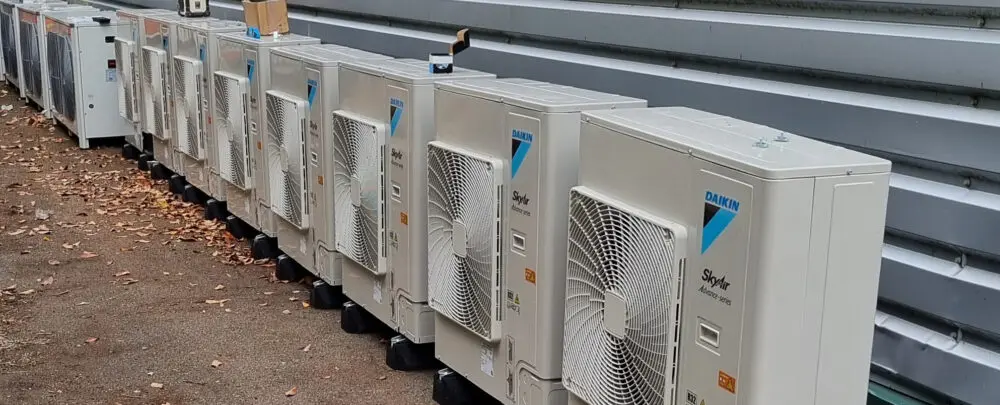Refrigerants for refrigeration systems – energy efficiency & the environment
Refrigerants are a key element in our daily lives, whether we are aware of it or not. They are utilised in a huge range of industries, from food and drink to pharmaceuticals, and are even used in our homes. With ongoing concerns about the welfare of our planet and its future, it’s important to understand the part refrigerants play when it comes to their impact.
MTCSS design cold rooms and temperature-controlled rooms with refrigeration systems, air conditioning and ambient temperature control – all of which utilise refrigerants to maintain specific temperatures required.
We select refrigerants based on individual requirements, budgets, and of course, their environmental impact and longevity. This takes into consideration current and upcoming regulations, F-gas regulations and the HFC phase down.
But what impact do refrigerants, commonly used in cold rooms and temperature control, have on the environment, energy usage and costs? MTCSS is here to help answer that question.
A2L Refrigerants
A2L refers to a specific range of refrigerants (that includes the commonly used R32) which meet a specific set of parameters. In this case:
- A – means the refrigerant is non-toxic
- 2 – means the refrigerant is flammable
- L – means the refrigerant has a low burning velocity
The burning velocity is below 10cm/sec, which is much lower than A3 refrigerants (referring to all hydro-carbon refrigerants). A2L refrigerants are less flammable than A3, and are a safe option for refrigeration systems, air conditioning and heat pump applications.
A2L have a low impact on the environment and have similar properties to HFC refrigerants. Compared to R134A, A2L (specifically A1234yf) offers over a 99% reduction on GWP (global warming potential). A2L refrigerants also offer better performance and efficiency than many A1 and natural refrigerants.
They are also anticipated to be suitable for long term usage, due to adhering to the increasingly strict environmental regulations.
A2L refrigerants must be used within new refrigeration and temperature control systems – they cannot be used for retrofitting systems containing A1 non-flammable refrigerants.
The range of A2L refrigerants includes: R1234yf, R1234z, R454C, R455A, R454A, R454B, R447A, R32, R452B.
R32 Refrigerants
As part of the A2L family, R32 is mainly used for air conditioning systems. It is considered a next generation refrigerant – it effectively carries heat, whilst having a lower environmental impact. It has a low GWP, is low toxic, difficult to ignite and non-explosive.
R32 is a single component refrigerant, meaning it’s also easier to reuse and recycle. And it uses familiar technology to efficiently convey heat, and it can reduce electricity usage.
CO2 as a Refrigerant
CO2 is a naturally occurring substance and is abundant in the atmosphere, resulting in CO2’s extremely low impact on the environment – with zero ODP (ozone depletion potential) and a GWP of one. But despite its benefits for the environment, it comes with its disadvantages.
Because CO2 is a high-pressure refrigerant – meaning high operating pressures are required for it to be used efficiently – it requires more complex systems which results in higher initial costs.
In addition to increased initial costs, systems that use CO2 can have a decline in system efficiency with increasing condensing temperatures – and CO2 is amongst the refrigerants with the steepest drop in efficiency as ambient temperatures rise.
But CO2 also has a higher energy content at higher temperatures. When the heat can be reclaimed to heat sanitary water (or used for other similar applications) the efficiency of the total systems can become much higher.
R449A Refrigerant
R449A is a mixture of commonly used HFCs (hydrofluorocarbons) and new HFOs (hydrofluoroolefins – which have zero ODP and low GWP) – a composition of R32, R125, R134A and R1234yf gases.
It has been assigned A1 safety classification because it is non-toxic and non-flammable, and is utilised in areas which require low to medium temperatures. Due the A1 classification, it is deemed safe in both new systems and for retrofitting.
Because of these factors its commonly used in supermarkets, cold rooms, refrigerated display cabinets, and self-contained refrigeration units such as monoblock systems.
R449A (1397 GWP) is replacing R404A in systems as it has around a 65% lower GWP. However, compared to A2L refrigerants A1234yf, with a 4 GWP, and A452B, with a 676 GWP – R449A has an increased impact on the environment.
Overall, each of these refrigerants have advantages and disadvantages. The lowest impact refrigerant is CO2, but this comes with increased costs and reduced efficiency.
A2L refrigerants have reduced environmental impact but are flammable, therefore unsuitable for certain systems and for retrofitting. R449A is non-toxic, non-flammable, can be used in new and existing systems, lower cost – but has a higher GWP than the previous refrigerants.
Selecting the refrigerant for your temperature control is dependent on a range of factors, including budget, temperature range, industry and more. The MTCSS team can design a system to your individual requirements and needs, taking into consideration environmental factors – want to find out more? Get in touch!
Call us on 01886 833381, email us at sales@mtcss.co.uk, or fill in an enquiry form here!


